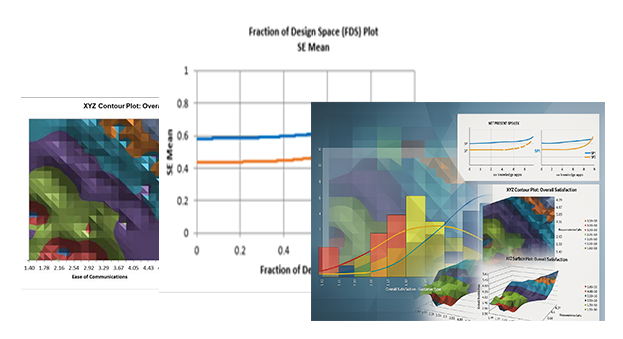ARIMA Multiple Seasonal Decomposition (MSD) Forecast
- Open Monthly Airline Passengers
- Series G.xlsx (Sheet 1 tab). This is
the Series G data from Box and Jenkins, monthly total
international airline passengers for January 1949 to December
1960. See the Run Chart, ACF/PACF Plots, Spectral.html
and Seasonal Trend Decomposition Plots for this data. The
Multiple Seasonal Decomposition (MSD) option is not necessary
for this data, but by way of introduction, we will use this to
compare to the previous ARIMA analysis.
- Click SigmaXL > Time Series
Forecasting > ARIMA Forecast > Multiple Seasonal Decomposition
Forecast. Ensure that the entire data table is
selected. If not, check Use Entire Data Table.
Click Next.
- Select
Monthly Airline Passengers, click
Numeric Time Series Data (Y) >>. Select Date,
click Optional Time Axis Labels >>. Check
Display ACF/PACF/LB Plots and Display
Residual Plots. Check Specify Model Periods.
Set Withhold Periods = 24. Select
Withhold Forecast Type: Multi-Step-Ahead with Prediction
Interval at Start of Withhold. Select Seasonal
Frequency Specify and enter 12. Check
Box-Cox Transformation and select
Rounded Lambda. We will use the default
Prediction Interval = 95.0 %.
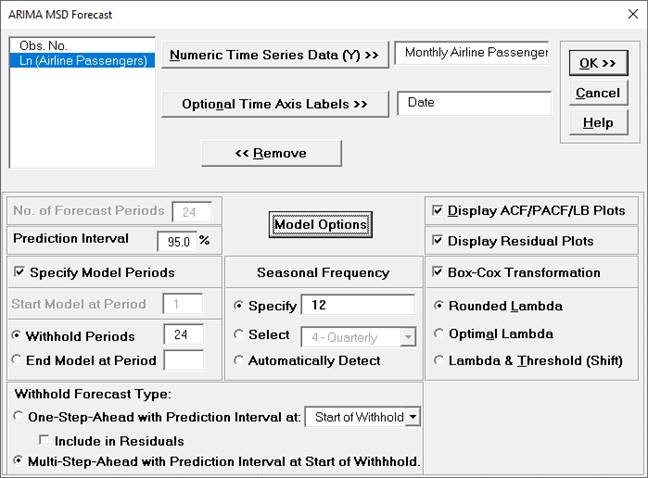
Seasonal Frequency can have multiple entries however, we
recommend no more than 3 values.
- Click Model Options.
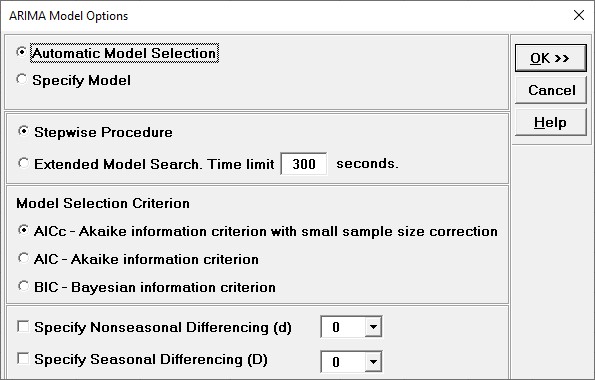
- We will use the default
Automatic Model Selection with AICc as
the Model Selection Criterion. Click OK
to return to the ARIMA MSD Forecast dialog. Click OK.
The ARIMA forecast report is given:
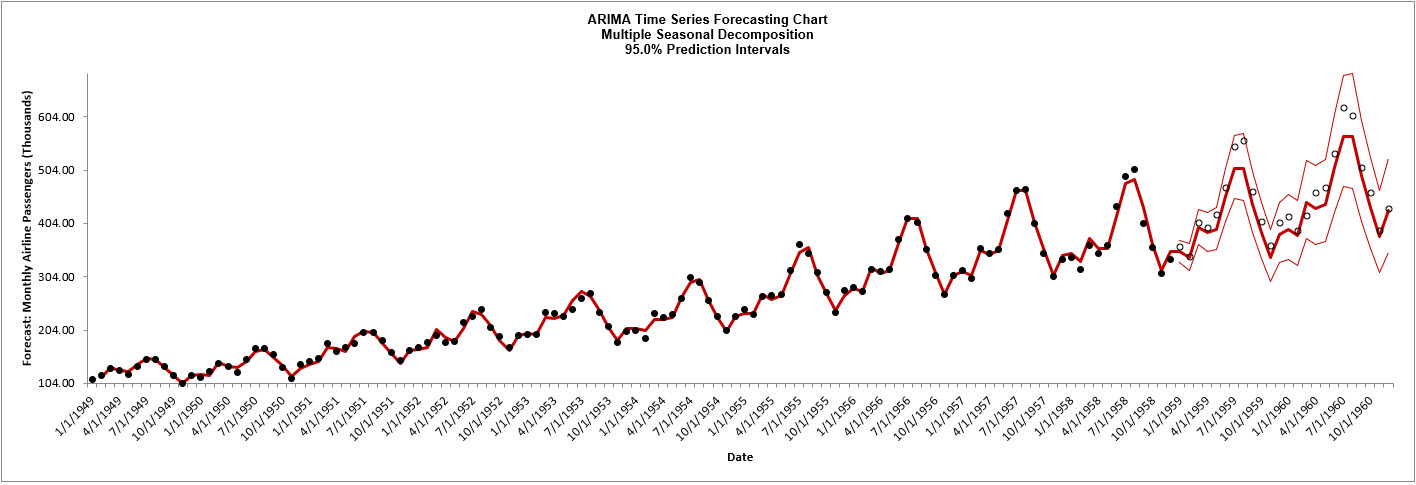
- Scroll down to view the ARIMA Model
header:

- The ARIMA Model Summary is given as:
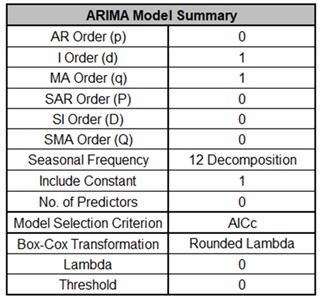
This is a summary of the model information for the
deseasonalized data: ARIMA (0,1,1) with a constant. Seasonal
Frequency = 12 using Decomposition and Model Selection Criterion
= AICc. There are no seasonal terms in the model. The Box-Cox
Transformation is Rounded Lambda with Lambda = 0 (Ln
transformation).
- The Parameter Estimates for the
deseasonalized Airline Passenger data are:

- The ARIMA Model Statistics are:
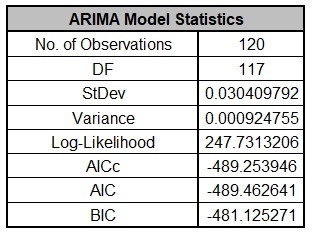
The number of observations, n = 144 24 (withhold) = 120
Degrees of freedom (DF) = 120 (n) 3 (2 terms in the model, 1 nonseasonal
difference) = 117
Note that the model statistics are based on the Ln transformed data, not the original
data.
Comparing to the Exponential Smoothing MSD Model Statistics, we see that the StDev and
Variance are approximately equal, but the Log-Likelihood, AICc, AIC and BIC are very
different. This is due to different formulas being used in the Likelihood function. You
cannot use Information Criteria to compare ARIMA and Exponential Smooth models to
determine which model has the best fit.
- The Forecast Accuracy metrics are:
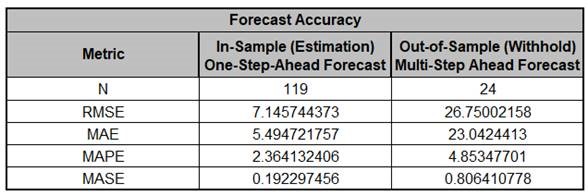
Comparing to Exponential Smoothing MSD Forecast Accuracy
metrics, we see that the ARIMA MSD results are approximately the
same.
Forecast Accuracy metrics are calculated using the actual
raw data versus inverse transformed forecast as displayed in the
Forecast Chart and Table, so allow comparison across all model
types and transformations.
- Click on the ARIMA MSD ACF PACF
LB sheet to view the ACF/PACF/LB Plots:
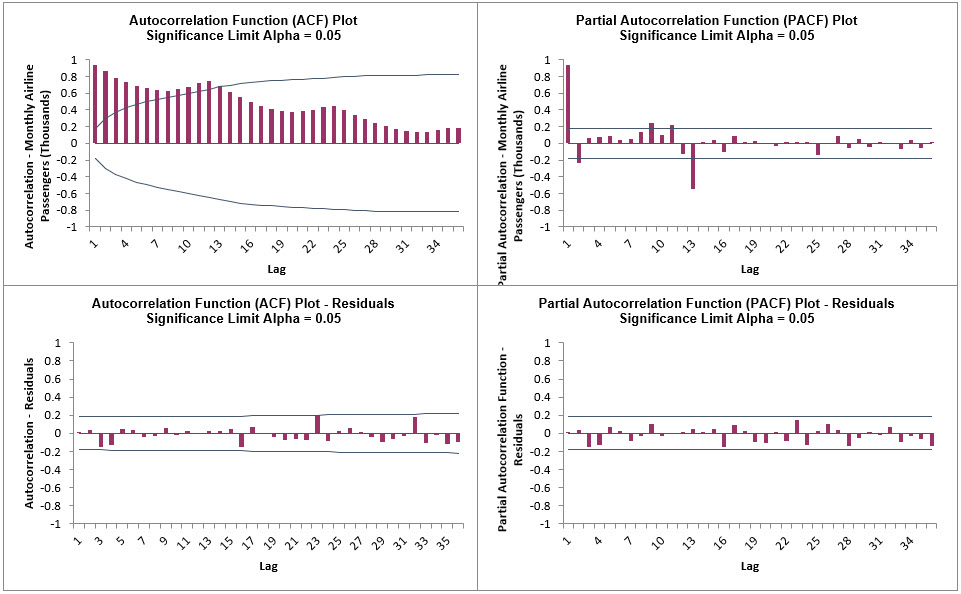
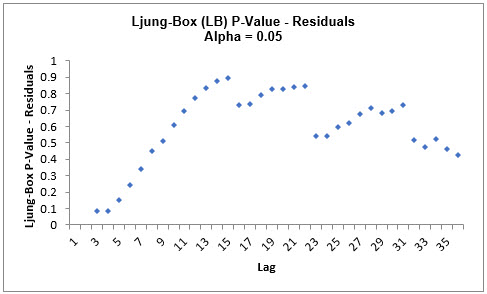
The ARIMA MSD ACF/PACF Residuals Plots are similar to the Exponential Smoothing MSD
ACF/PACF/LB Plots and indicate that the autocorrelation has been accounted for in the
model. All of the Ljung-Box P-Values are blue (i.e., not significant), with P-Values
> .05.
- Click on the ARIMA MSD Residuals sheet
to view the Residual Plots:
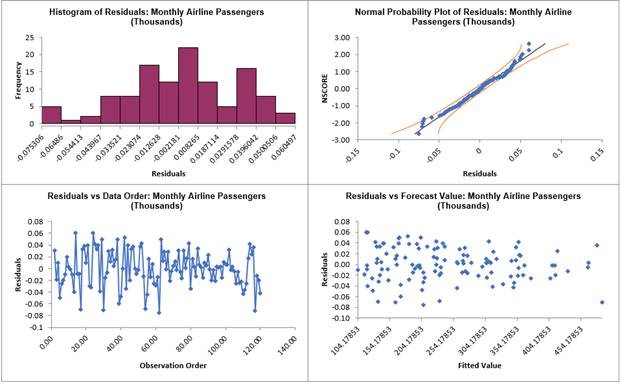
The residuals are approximately normally
distributed, with a roughly straight line on the normal probability plot. There are no
obvious extreme outliers or patterns in the charts. The residual plots are approximately
the same as those given previously in Exponential Smoothing MSD Residual
Plots.
Since a Box-Cox transformation was used, the residuals are in Ln
transformed units.
- Open Half-Hourly Multiple
Seasonal Electricity Demand - Taylor.xlsx (Sheet
1 tab). This is half-hourly electricity demand (MW) in
England and Wales from Monday, June 5, 2000 to Sunday, August
27, 2000 (taylor, R forecast). This data has multiple
seasonality with frequency = 48 (observations per day) and 336
(observations per week), with a total of 4032 observations. See
the Run Chart, ACF/PACF Plots, Spectral.html and
Seasonal Trend Decomposition Plots for this data.
- Click SigmaXL > Time Series
Forecasting > ARIMA Forecast > Multiple Seasonal Decomposition
Forecast. Ensure that the entire data table is
selected. If not, check Use Entire Data Table.
Click Next.
- Select Demand, click
Numeric Time Series Data (Y) >>. Check Display
ACF/PACF/LB Plots and Display Residual Plots.
Check Specify Model Periods. Set
Withhold Periods = 96. Select Withhold Forecast
Type: Multi-Step-Ahead with Prediction Interval at Start of
Withhold. Check Seasonal Frequency
with Specify = 48 336. Leave Box-Cox
Transformation unchecked. We will use the default
Prediction Interval = 95.0 %.
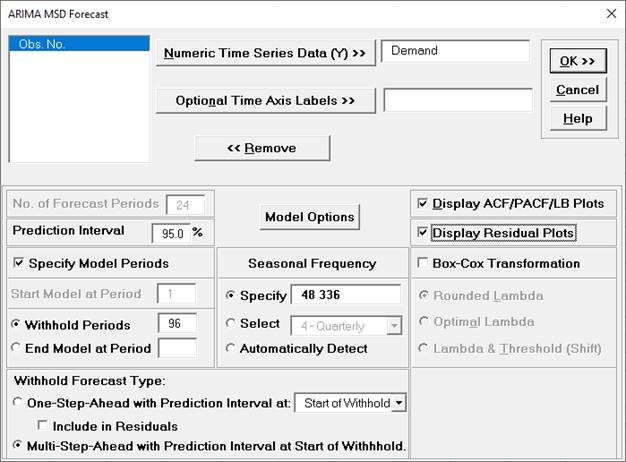
Withhold Periods is 2*dominant seasonal
frequency (48). Dominant frequency is obtained from the Spectral
Density Plot. Start Model at Period = 1 is always greyed out for
MSD.
- Click Model Options.
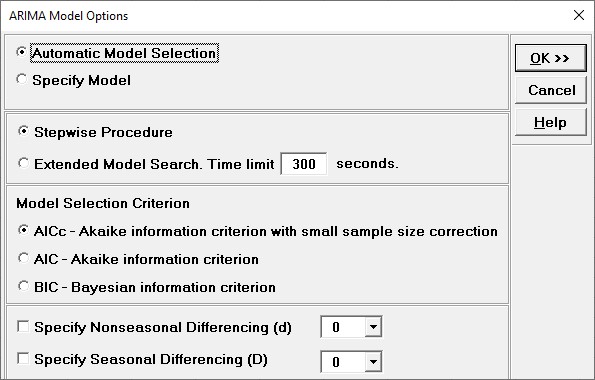
- We will use the default
Automatic Model Selection with AICc as
the Model Selection Criterion. Click OK
to return to the ARIMA MSD Forecast dialog. Click OK. The ARIMA
forecast report is given:
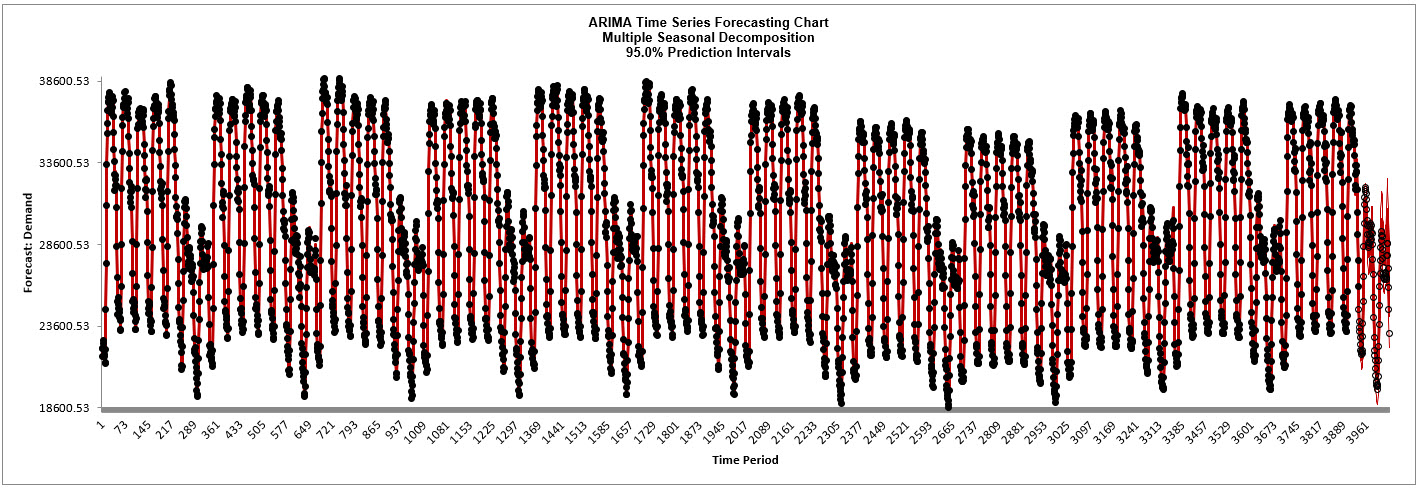
- We will want
to zoom in on the last 3 days, i.e., 144 half-hourly time
periods, using chart scrolling. Click SigmaXL Chart
Tools > Enable Scrolling

You may be prompted with a warning message that custom
formatting on the chart will be cleared. You can avoid seeing
this warning by checking Save this choice as default and
do not show this form again.
- Click OK. The scroll
dialog appears allowing you to specify the Start Period
and Window Width. Enter Start Period
= 3888 and Window Width = 144:
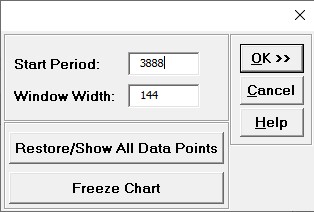
At any point, you can click
Restore/Show All Data Points or Freeze Chart. Freezing
the chart will remove the scroll and unload the dialog. The scroll dialog will also
unload if you change worksheets. To restore the dialog, click
SigmaXL Chart Tools > Enable Scrolling.
-
Click OK. A scroll bar appears beneath the
forecast chart. You can also change the Start Subgroup
and Window Width and Update.
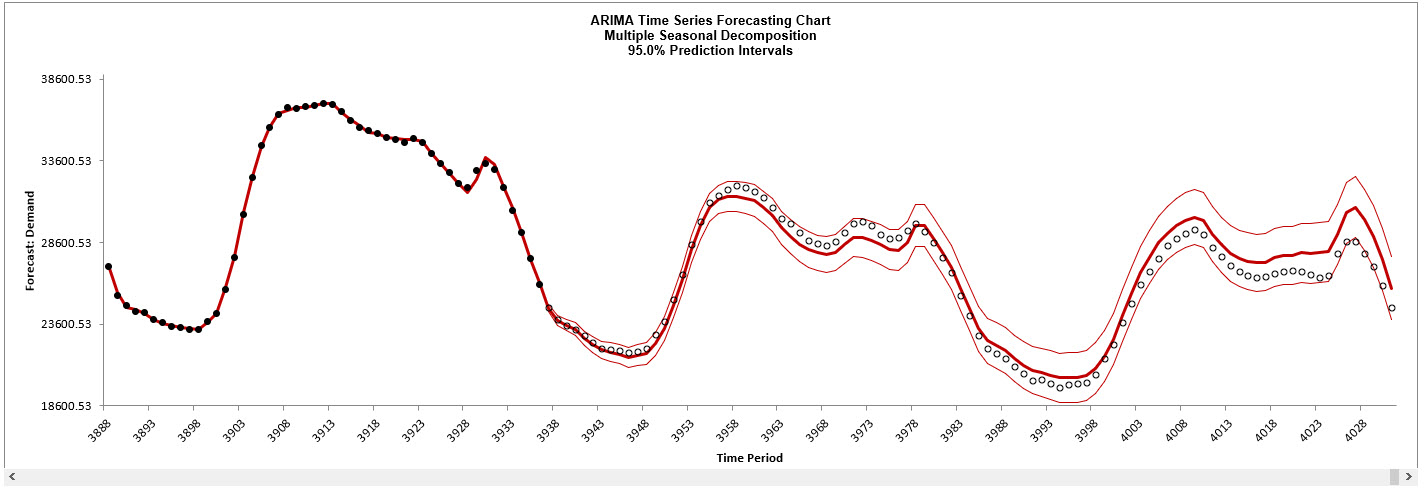
You can scroll through by clicking to the right or left, with the specified window width
of 144.
The blank dots are the data values in the withhold sample with a multi-step forecast and
prediction intervals displayed at the start of the withhold sample. The model does quite
well at predicting the withhold 96 half-hour demand values. Note that the prediction
error increases the further out we predict. The ARIMA MSD Forecast Chart looks
approximately the same as the previous Exponential Smoothing MSD Forecast Chart.
Click Cancel to exit the scroll dialog.
- Scroll down to view the ARIMA Model
header:

- The ARIMA Model Summary is given as:
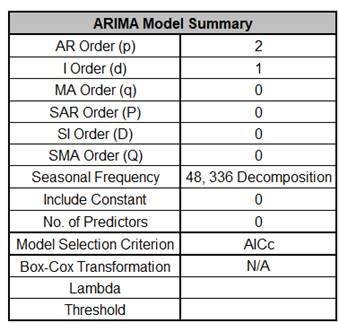
This is a summary of the model information for the
deseasonalized data: ARIMA (2,1,0) without a constant. Seasonal
Frequency = 48, 336 using Decomposition and Model Selection
Criterion = AICc. There are no seasonal terms in the model.
- The Parameter Estimates for the
deseasonalized Demand data are:

ARIMA Parameter Estimates include significance tests; P-Values <
.05 are significant and highlighted in red. This may be useful
for model refinement with multiple predictors but for AR/MA
model order selection, minimum AICc should be used, rather than
significance tests (see Kostenko, A.V. and Hyndman, R.J. ).
- The ARIMA Model Statistics are:
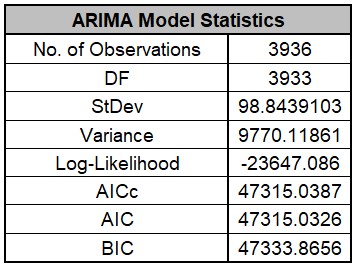
The number of observations, n = 4032 96 (withhold) = 3936
Degrees of freedom (DF) = 3936 (n) 3 (2 terms in the model, 1 nonseasonal
difference) = 3933
Note that the model statistics are calculated using the deseasonalized data.
- The Forecast Accuracy metrics are:

As expected, the Out-of Sample (Withhold) Multi-Step-Ahead
Forecast errors are larger than the In-Sample (Estimation)
One-Step-Ahead Forecast errors. Note, if we were primarily
interested in a short term one-step ahead forecast, then we
would have selected Withhold Forecast Type: One-Step-Ahead and
the above table would show Out-of-Sample (Withhold)
One-Step-Ahead Forecast errors.
Comparing to the previous Exponential Smoothing MSD Forecast
Accuracy metrics, we see that the ARIMA MSD results are
approximately the same.
Forecast Accuracy metrics are calculated using the actual raw
data versus forecast as displayed in the Forecast Chart and
Table so, unlike the model statistics above, allows comparison
across all forecast model types and transformations.
- The Forecast Table is given as:

These are the same forecast and prediction interval values displayed in the Forecast
Chart, but provided for further analysis or charting (e.g., a run chart of the forecast
errors). The
Withhold Data is also displayed.
- Click on the ARIMA MSD ACF PACF
LB sheet to view the ACF/PACF/LB Plots:
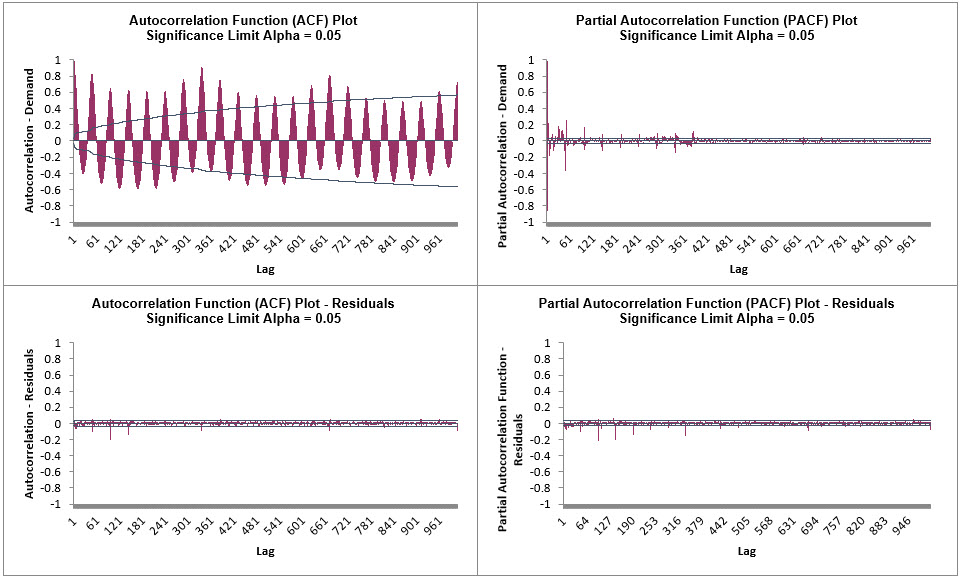
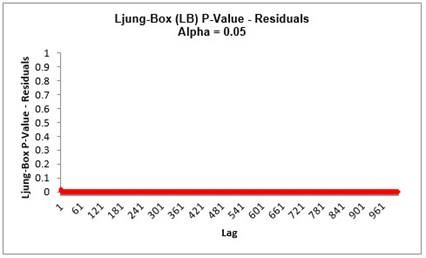
The ACF/PACF Residuals Plots indicate that much of the
autocorrelation has been accounted for in the model, but the
Ljung-Box plot shows that some significant autocorrelation still
remains (the red P-Values are significant at alpha=.05) - so the
model can potentially be improved. This does not mean that the
model is a bad model, it can still be very useful for prediction
purposes, but the prediction intervals may not provide accurate
coverage.
- Click on the ARIMA MSD
Residuals sheet to view the Residual Plots:
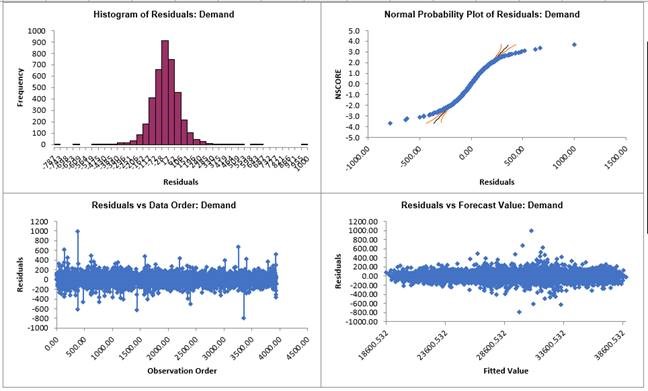
Similar to the Exponential Smoothing MSD
Residual Plots, the residuals are not normally distributed and there are extreme
outliers. These should be investigated with a control chart on the residuals. Outliers
in Electricity Demand are often explained by Temperature.
ARIMA does not have a theoretical frequency limit, but for computational efficiency and to
minimize the potential loss of observations through differencing, we recommend using ARIMA
Multiple Seasonal Decomposition (MSD) for seasonal frequency greater than 52 (or with
multiple frequencies).
The seasonal component is first removed through decomposition, a nonseasonal ARIMA model
fitted to the remainder (+trend), and then the seasonal component is added back in. For
forecasting, a nave seasonal forecast is used on the seasonal component. Note that the
prediction intervals are derived from the ARIMA model and do not include uncertainty in the
seasonal component.
As the name implies, Multiple Seasonal Decomposition (MSD) also accommodates multiple seasonality, for example the half-hourly data with a seasonal frequency of 48 observations per day and 336 observations per week. When using MSD, it is recommended to limit the forecast period to 2*dominant seasonal frequency.
